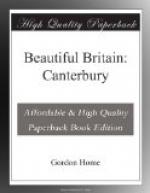Ascending some more steps, the modern pilgrim reaches Trinity Chapel, where his eyes, instead of falling upon a shrine encrusted with jewels and precious metals, merely look between the pillars upon an empty space. A vacant spot, however, can be eloquent enough, and to those who have read Chaucer’s “Canterbury Tales” or the late Mr. Snowden Ward’s “Canterbury Pilgrimages,” if they have gone no farther in the study of this fascinating cult, the site of the shrine whose fame was European is able to give almost as deep a thrill as any experienced by the wayworn folk of the Middle Ages.
By going closer and examining the pavement, a shallow groove appears marking the exact position of the base of the shrine. This was worn by the endless stream of pilgrims as they knelt in ecstasy before the object their eyes had longed to feast upon. To the west is a fine thirteenth-century mosaic pavement similar to that in the Confessor’s Chapel at Westminster Abbey, to which it is very fitting to compare this chapel, for if it is not quite a “Chapel of the Kings” it has a King—Henry IV.—and a king’s eldest son—the Black Prince—on either side, and after Westminster Abbey there was scarcely a more sacred spot in the kingdom than this.
It was fitting that Henry IV. should be buried here, for he had taken a considerable amount of interest in the rebuilding of the nave, and had been liberal in his financial aid. The effigies of Henry and his second wife, Joan of Navarre, are believed to be faithful representations. Of the tomb of Edward the Black Prince, if space permitted, much could be said, for it is a magnificent piece of work apart from the historical interest that attaches to the soldier Prince, whose two great victories at Crecy and Poitiers have thrilled every English schoolboy during all the subsequent centuries. The strong iron railing has prevented any damage to the bronze or latten effigy, and except for the tarnishing and general deterioration of gilding and paint, one looks on the monument as it was erected in the days of chivalry. All the details of this tomb had been arranged by the Black Prince himself, and it was he who chose the Norman-French inscription all can plainly read to-day. Above the tomb is suspended a flat canopy of wood with an embattled moulding, and on the underside a much decayed painting of the Trinity, if one may call it such when the Dove is not represented. On the beam from which the canopy is suspended are hung the shield, helmet, velvet coat, brass gauntlets, and empty sword sheath which are the survivals of two complete suits, one for peace, and one for war, which were carried at the funeral as the Prince had ordered in his will.




